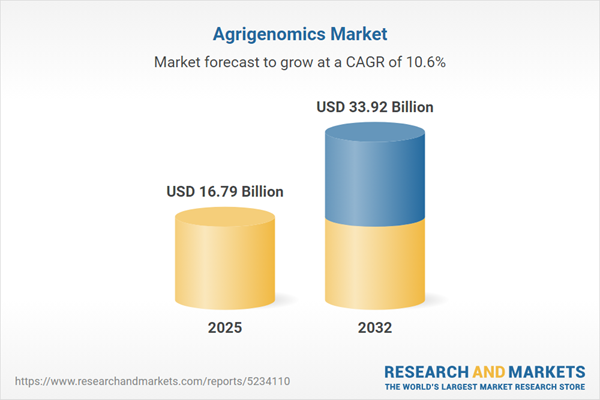Speak directly to the analyst to clarify any post sales queries you may have.
The agrigenomics market is transforming agricultural operations for senior decision-makers, driving the adoption of advanced genomic tools that enable improved efficiency, sustainability, and competitive differentiation in a dynamic regulatory and technological environment.
Market Snapshot: Agrigenomics Market Growth and Trends
The global agrigenomics market is experiencing strong momentum, propelled by the broad integration of genomic technologies across crop and livestock production. Currently valued at USD 15.16 billion and projected to reach USD 33.92 billion by 2032, the market reflects a compound annual growth rate of 10.58%. Leading industry organizations are embedding genomics-driven solutions within business functions, translating laboratory discoveries directly into agri-business strategy. This expansion is supported by the use of sophisticated laboratory techniques, modernization efforts, robust regulatory standards, and evolving business models. These factors are collectively expediting innovation and offering a strategic advantage for organizations prepared to lead through scientific progress and market shifts.
Scope & Segmentation: Strategic Insights for the Agrigenomics Market
This report equips senior leaders with a precise overview of market segmentation and practical intelligence on genomics adoption and regulatory pathways in the agricultural sector. Well-defined segments and explicit detail offer actionable data for compliance and risk management across global operations.
- Product Type: Consumables, instruments, software, and services that streamline agricultural diagnostics and foster scalable research efforts.
- Consumables: Essential reagent kits and genotyping materials critical for research development and scaling operational capacity.
- Instruments: PCR systems, sequencers, and microarray platforms facilitating comprehensive genetic analysis and refined breeding selection.
- Software and Services: Integrated bioinformatics tools and consultancy services improving project management and operational productivity.
- Technology: DNA sequencing, gene editing, genotyping, transcriptomics, and bioinformatics underpin advanced diagnostics and resource planning.
- Bioinformatics: High-level analytics identify actionable traits, strengthen yield forecasts, and enhance resilience in crops and livestock.
- DNA Sequencing: Detailed genetic profiling supports precision breeding initiatives tailored for diverse agricultural demands.
- Gene Editing: Technologies such as CRISPR and TALEN introduce advantageous traits, improving adaptability and optimizing resource use.
- Genotyping: Reliable selection tools support operational efficiency and yield maximization across commercial farming domains.
- Transcriptomics: Monitoring gene expression advances health management practices for a wide range of agricultural species.
- Application: Disease management, plant and animal health innovation, supply chain optimization, and trait-specific nutritional solutions.
- End User: Biotechnology companies, seed producers, academic institutions, and public organizations driving sector innovation.
- Regions: Significant market activity in the Americas, EMEA, and Asia-Pacific with focused trends in the United States, Brazil, Germany, India, and China.
- Corporate Developments: Notable strategies and investments by sector leaders including Bayer AG, Corteva, Syngenta AG, Illumina, and Thermo Fisher Scientific.
Comprehensive segmentation gives senior leaders a clear framework for targeting compliance, partnering effectively, and managing risk in diverse regulatory environments.
Agrigenomics Market: Key Takeaways for Senior Leaders
- Integrating genomics enhances strategic planning, supporting operational coherence from research through to distribution.
- Collaboration between the public sector, academia, and private industry accelerates technology adoption and increases implementation effectiveness.
- Advanced data analytics are strengthening risk mitigation strategies and support the integration of sustainability goals across operations.
- Deeper regional and sectoral insights empower organizations to identify and capitalize on targeted growth opportunities at every stage of maturity.
- Strong partnerships within the supply chain reinforce operational resilience and adaptability to market changes.
- Segment-focused strategies help decision-makers align with regulatory trends and pursue effective compliance worldwide.
Tariff Impact: Navigating Policy-Driven Market Shifts
Imminent updates to U.S. tariffs in 2025 are compelling agrigenomics organizations to reassess supply chain structure. Prioritizing domestic sourcing and diversified networks is helping companies stabilize input costs and uphold compliance amid evolving international trade dynamics.
Methodology & Data Sources
This analysis is based on executive-level interviews, industry expert evaluations, patent database reviews, and authoritative regulatory analysis. Data validation is achieved through cross-referencing with reliable industry sources, ensuring decision-makers have access to the most current and actionable intelligence for agrigenomics market positioning.
Why This Report Matters
- Enables leadership to anticipate shifts in the agrigenomics market by providing market-driven insights and risk-based scenarios.
- Supports prudent decision-making with real-world benchmarks for technology implementation, supply chain strength, and forward-focused planning.
- Prepares organizations to rapidly adapt and maintain competitive advantage in the face of shifting regulatory and operational conditions.
Conclusion
This report provides senior executives with the essential insights needed to accelerate genomics integration, ensure regulatory alignment, and advance sustainability, strengthening their ability to lead successfully in a changing global marketplace.
Additional Product Information:
- Purchase of this report includes 1 year online access with quarterly updates.
- This report can be updated on request. Please contact our Customer Experience team using the Ask a Question widget on our website.
Table of Contents
3. Executive Summary
4. Market Overview
7. Cumulative Impact of Artificial Intelligence 2025
Companies Mentioned
The companies profiled in this Agrigenomics market report include:- Bayer AG
- Corteva, Inc.
- Syngenta AG
- BASF SE
- Illumina, Inc.
- Thermo Fisher Scientific Inc.
- QIAGEN N.V.
- Agilent Technologies, Inc.
- Bio-Rad Laboratories, Inc.
- Merck KGaA
Table Information
| Report Attribute | Details |
|---|---|
| No. of Pages | 184 |
| Published | November 2025 |
| Forecast Period | 2025 - 2032 |
| Estimated Market Value ( USD | $ 16.79 Billion |
| Forecasted Market Value ( USD | $ 33.92 Billion |
| Compound Annual Growth Rate | 10.5% |
| Regions Covered | Global |
| No. of Companies Mentioned | 11 |









